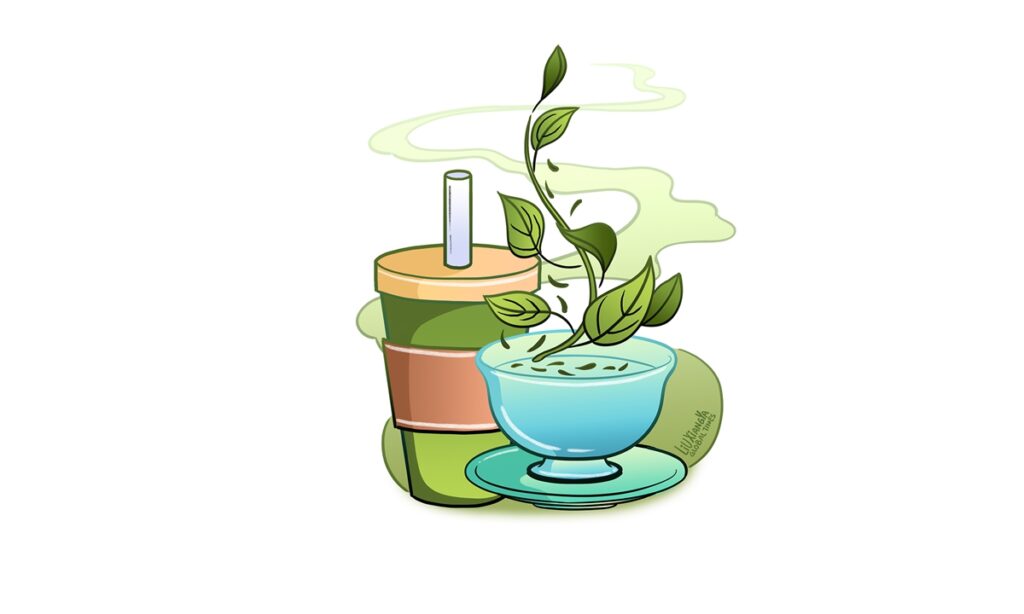Chinese culture is incomplete without tea. We place prepared tea leaves into a tea bowl, pour in boiled water, and the unique fragrance of tea polyphenols begins to permeate the air. At this moment, regardless of the occasion, a touch of tradition begins to unfurl.
The journey of tea commences long before this step.
Amid this scorching summer, with temperatures soaring to 40 C, a scene unfolds in a village in Laimu township, Southwest China’s Sichuan Province. Here, the young mayor of the town, Tong Xiaodong, strides over a slope, meticulously surveying rows of tea bushes, which have just undergone the summer harvest, and with proper nurturing, they hold the promise of yielding another bountiful crop in autumn.
The expanse of tea gardens in Laimu stretches across a staggering 40,000 mu (2,666 hectares), a testament to the region’s dedication to this cherished tradition. From this seemingly modest terrain, tea produced here extends, even to distant Africa. Tea has also transformed the life of more than 7,000 tea farmers into one of opulence and comfort.
A single tea plant can yield several harvests of tea leaves within a year. Spring tea, known for its lightness, carries a lingering aftertaste and embodies a refined flavor, especially when the leaves are plucked before the Qingming Festival in April. The care lavished upon these leaves by tea farmers can best be described as “nurturing.” During the spring harvest, those gathering the tea leaves abstain from alcohol and tobacco. Beyond being a cultural gesture of respect, this practice serves a practical purpose – ensuring that the harvesters approach their task with the utmost clarity of mind and agility of body to discern the freshest, tender leaves from each tea plant.
There are even more intriguing practices. It is said that in certain ancient locales, the pluckers of Mingqian (pre-Qingming) tea were prohibited from engaging in sexual activities. This was believed to further elevate their attentiveness and vitality, imbuing the harvested leaves with a distinct essence of purity and vitality.
However, the leaves harvested during the summer and autumn seasons don’t quite enjoy such privileged treatment. The yield during these seasons is substantial, leading many tea-producing regions to employ mechanical harvesting methods. Additionally, due to their bolder flavor profiles, they do not align with the traditional Chinese aesthetics of tea appreciation. As Mayor Tong aptly put it, summer tea tends to be bitter, while autumn tea leans toward a more astringent taste.
Thus, within China’s rich history of tea consumption and tea trade spanning millennia, summer and autumn teas have been regarded as “staple teas” for everyday, casual sipping. Their purpose is to infuse a difference into drinking water. Given their robust character, they are essentially excluded from the elite ranks of the “aristocratic” circle of high-end tasting. Within China’s traditional hospitality customs, if you possess spring tea but opt to serve your guests summer or autumn tea, it is considered a rather discourteous gesture.
However, a seismic shift has already taken place as the seasons are changing.
Tong shared with us that this robust flavor profile is now gaining tremendous traction among today’s younger generation. In the bustling urban landscape, where thousands of “milk tea” shops occupy city streets in every town, contemporary beverage establishments are precisely seeking out teas that are rich of and carry a touch of bitterness.
If milder spring teas were used, their delicate flavors would be overwhelmed by the presence of other ingredients such as fruit and milk. Only summer and autumn teas can surmount the blockade posed by various flavor elements, allowing these delightful beverages to retain the fundamental essence of “tea.”
This particular nuance has ushered in a realm of significant commercial opportunities.
From the very same tea plant, the spring harvest caters to the refined palate of traditional culture, while the summer and autumn yields seamlessly integrate into the pulse of contemporary urban life. Within this cadence, those who cultivate the tea and those who relish it partake in the same whisper of tea aroma.
(Global Times)




